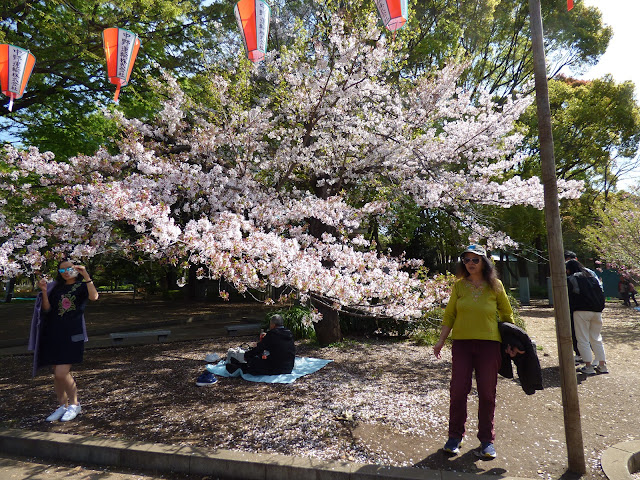DAY 2, Apr 13 Saturday, 2024:
Senso-ji temple, Ueno park, Shinjuku park
These were all cherry blossoms sites and the first two were quite close to our apartment.
We started off early by 7:00 AM and took the local train Chūō-Sōbu Line to AsakusaBashi and transferred and reached Asakusa station. This was kind of a rehearsal for our next day's day trip to Nikko.
Maps below show stations we used
Our apt station Hirai is the next one to Kamaido station circled with an extended line below.... for some reason maps don't have all stations
the 2nd map has our Hirai station
It was a short walk to senso-ji temple, it's usually very crowded but in the early hours of the morning it was a serene experience.
Senso-ji (浅草寺, Sensōji, Asakusa Kannon Temple)
It is the oldest and most famous Buddhist temple in Tokyo founded in 645 AD.
Kaminarimon (雷門, "Thunder Gate") is the outer of two large entrance gates that leads to the Sensō-ji in Asakusa. It was constructed over 1000 years ago by a samurai general, to fulfill his desire for peace and prosperity. The gate suffered damages from several fires; its current form was donated by the founder of the famous Japanese electrical manufacturer, Panasonic.
Its impressive paper lanterns, which are 3.9m high with a 3.3m diameter, and weighing about 700kg, are replaced every decade or so.
Four statues are housed in the Kaminarimon, two in the front alcoves and two in the back. In the pic above, Guardian deities...Tenryū (Heavenly Dragon) on the east side, and the goddess Kinryū (Golden Dragon) on the west side.
The statues of the Shinto gods Fūjin and Raijin are displayed on the front of the gate
Nakamise dori
this is the commercial street Nakamise dori, one of the oldest commercial districts in Japan, with well-established eateries and souvenir shops. We were here at 7.20am, so shops were yet to open. The shutters had lovely paintings though.
Five-storey pagoda
Within the vicinity of Sensoji Temple stands a stately five-storey pagoda devoted to Kannon Bosatsu, the Goddess of Mercy. This Pagoda was originally built in 942, along with the main hall of Sensoji Temple.
Pagodas are tower-like structures seen in the precincts of Buddhist temples. Also known as a stupa, it contains the ashes of the Buddha. Buddha's ashes, officially obtained from the Isurumuniya temple in Sri Lanka, is stored on the top floor.
Its height is 53.32 meters, which is about the height of an 18-storey building.
lovely tulips in full bloom...
Sacred Cleansing fountain...A Temizuya is a water ablution pavilion at the entrance to most Shinto shrines in Japan, for the cleansing rite known as Temizu
Map of the whole site...
Its height is 53.32 meters, which is about the height of an 18-storey building.
lovely tulips in full bloom...
Sacred Cleansing fountain...A Temizuya is a water ablution pavilion at the entrance to most Shinto shrines in Japan, for the cleansing rite known as Temizu
MAIN PRAYER HALL
Note Gokyuden, the room inside the main prayer hall. This is a special room for the Kannon Bodhisattva, with a gorgeous interior filled with gold-plated, elaborate sculptures.
Garden
Map of the whole site...
Then again it was a short ride to Ueno Park.
We had assumed we'll just enjoy the cherry blossoms there but the Toshagu shrine was amazing as well; there was a special exhibition of peonies and that was fantastic. the Tokyo National Museum is open up to 7:00 PM on weekends, so we put it off for another day.
Ueno Park (上野公園, Ueno Kōen)
Established in 1873. The home of a number of major museums, Ueno Park is also celebrated in spring for its cherry blossoms and hanami.
The park and its attractions have drawn over ten million visitors a year, making it Japan's most popular city park
The park has some 8,800 trees, including Ginkgo biloba, Cinnamomum camphora, Zelkova serrata, Formosan cherry, Somei-Yoshino cherry, and Japanese cherry. Awesome sight
Some plastic sheets were given under all the blooming cherry trees for people to sit on.
Some plastic sheets were given under all the blooming cherry trees for people to sit on.
it was a weekend and locals started arriving and having their Hanami parties with food and drinks of their choice.
several were dressed in traditional kimono attires and it was a very pretty sight
kid statue pointing to the blooming cherry tree...Time on the clock is 9:15
avenue of cherry trees...
totem pole
kid statue pointing to the blooming cherry tree...Time on the clock is 9:15
avenue of cherry trees...
PEONY EXHIBITION:
1000yen entry... each nook was pretty, totally worth it
ShōgunTokugawa Ieyasu is enshrined at Ueno Tōshō-gū, dating to 1651. He was the third shōgun of the Tokugawa dynasty. [ shōguns were military rulers of Japan during 1185 to 1868. Nominally appointed by the Emperor, shoguns were usually the de facto rulers of the country]
totem pole
“Ema”: Wooden Tablets Bearing Wishes for Good Luck and Success
Ema are wooden tablets, often with colorful designs, on which people write their wishes for the future before hanging them up at shrines and temples in a common Japanese tradition.
Statue of Saigō Takamori walking his dog...he was a Japanese samurai and nobleman. He was one of the most influential samurai in Japanese history and one of the three great nobles who led the Meiji Restoration. "the quintessential hero of modern Japanese history"
Equestrian statue of Prince Komatsu Akihito...
Statue of Saigō Takamori walking his dog...he was a Japanese samurai and nobleman. He was one of the most influential samurai in Japanese history and one of the three great nobles who led the Meiji Restoration. "the quintessential hero of modern Japanese history"
SHINJUKU PARK
Then we took a long ride to Shinjuku Park, this was also a rehearsal for taking our bus for a day trip to Kawaguchiko to see Mount Fuji the day after Nikko trip..
There were huge lines to enter the park and quite chaotic, by mistake we entered with groups and then branched off and got our ticket fast. There were lot of cherry blossoms here as well.
Hanami parties by local families...WATER REFLECTIONS
water bodies... the Japanese do it so well.
Amazing reflections adding to the total ambience
an artist painting the scene...
We were exhausted by 4:30 and and left the park. It was a great first day in Tokyo/Japan.
an artist painting the scene...
We were exhausted by 4:30 and and left the park. It was a great first day in Tokyo/Japan.
The report continues here
























































































































No comments:
Post a Comment